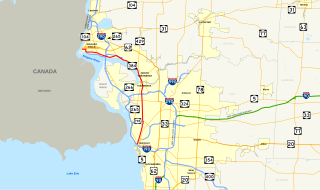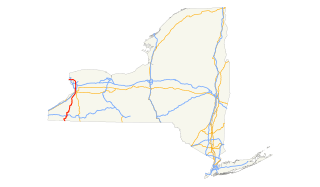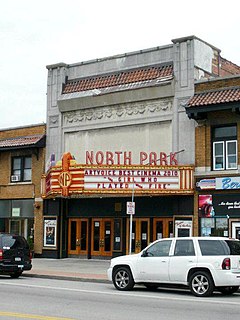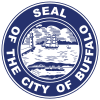
Erie County is a highly populated county in the U.S. state of New York. As of the 2010 census, the population was 919,040. The county seat is Buffalo. The county's name comes from Lake Erie. It was named by European colonists for the regional Iroquoian language-speaking Erie tribe of Native Americans, who lived south and east of the lake before 1654.

Amherst is a town in Erie County, New York, United States. Amherst is the most populated town in upstate New York, and an inner ring suburb of Buffalo. As of the 2010 census, the town had a total population of 122,366. This represents an increase of 5.0% from the 2000 census.

Kenmore is a village in Erie County, New York, United States. The population was 15,423 at the 2010 census. It is part of the Buffalo–Niagara Falls metropolitan area.

The Pan-American Exposition was a World's Fair held in Buffalo, New York, United States, from May 1 through November 2, 1901. The fair occupied 350 acres (0.55 sq mi) of land on the western edge of what is now Delaware Park, extending from Delaware Avenue to Elmwood Avenue and northward to Great Arrow Avenue. It is remembered today primarily for being the location of the assassination of United States President William McKinley. The exposition was illuminated at night. Thomas A. Edison, Inc. filmed it during the day and a pan of it at night.

Tonawanda is a city in Erie County, New York, United States. The population was 15,130 at the 2010 census. It is at the northern edge of Erie County, south across the Erie Canal from North Tonawanda, east of Grand Island, and north of Buffalo. It is part of the Buffalo-Niagara Falls metropolitan area.

The Niagara Frontier Transportation Authority (NFTA) is a New York State public-benefit corporation responsible for the public transportation oversight of Erie and Niagara counties in the state of New York. The NFTA, as an authority, oversees a number of subsidiaries, including the NFTA Metro bus and rail system, the Buffalo-Niagara International Airport, the Niagara Falls International Airport and NFTA Small Boat Harbor. The NFTA Metro bus and rail system is a multi-modal agency, utilizing various vehicle modes, using the brand names: NFTA Metro Bus, NFTA Metro Rail, NFTA Metrolink and NFTA PAL.

LaSalle is a Buffalo Metro Rail underground station located at the corner of Main Street and LaSalle Avenue and is one stop from the northern terminus. Original drafting plans had the station used as a turnout between the current Metro Rail line and three proposed extensions; the Tonawanda Line, which would extend service into the cities of Tonawanda and Niagara Falls; the North Buffalo Line, which would extend service to Elmwood Avenue on an abandoned railroad right-of-way between Hertel and Kenmore Avenues; and the East Buffalo line, to connect the Main Street line with the proposed Airport Line, carrying passengers to the Buffalo-Niagara International Airport. The only visible sign of the turnout is located below ground by way of partially finished tunnel just west of the LaSalle station platforms. From May 20, 1985 to November 10, 1986, due to construction issues at LaSalle station, Amherst Street station served as the northern terminus. Since November 10, 1986, University station serves as the northern terminus.

University is a Buffalo Metro Rail station located near the intersection of Main Street and Niagara Falls Boulevard on the University at Buffalo South Campus. It is a major transfer point between Metro Rail and many city and suburban bus routes and offers a unique "Kiss and Ride" facility on the top level, above the mezzanine. This allows drivers of automobiles a separate area to drop off passengers, so they do not add to the traffic congestion from buses at the station during rush-hour periods and a large park-and-ride facility directly to the east of the station. Since University station serves as a terminal, immediately south is a double crossover. From May 20, 1985 to November 10, 1986, due to construction issues at LaSalle station, Amherst Street station served as the northern terminus. Since November 10, 1986, University station serves as the northern terminus.

New York State Route 324 (NY 324) is an east–west state highway located in the western portion of New York in the United States. Officially, NY 324 begins at NY 384 in Niagara Falls and overlaps Interstate 190 south to Grand Island, where it separates from I-190 and continues southward as Grand Island Boulevard. As signed, however, NY 324 begins at the southern end of the official overlap and is contained entirely within Erie County. At the southern edge of Grand Island, NY 324 joins I-190 to cross over to the mainland, where it runs due east across three towns before reaching its eastern end at a junction with NY 5 in the town of Clarence.

New York State Route 265 (NY 265) is a 19.75-mile (31.78 km) long state highway located in the western part of New York in the United States. NY 265 is a north–south route that roughly parallels the western parts of the Niagara River in Erie County and Niagara County. For much of its southern course, it is more frequently referred to by its longtime name, Military Road, which dates back to 1801 as a road to connect the city of New Amsterdam and Fort Niagara near Lake Ontario.

New York State Route 384 (NY 384) is a state highway in Western New York in the United States. It is a north–south route extending from the city of Buffalo, Erie County to the city of Niagara Falls, Niagara County, and is one of several routes directly connecting the two cities. The southern terminus of the route is at NY 5 in downtown Buffalo. NY 384's northern terminus is at the Rainbow Bridge in downtown Niagara Falls. Through its entire course in Erie County, it is known as Delaware Avenue for the street it follows in the city. In Niagara County, NY 384 follows the Niagara River and is named River Road and Buffalo Avenue.
The Citizens Regional Transportation Corporation (CRTC) is a grass-roots organization promoting the implementation and expansions of light-rail service for the City of Buffalo and the surrounding Buffalo/Niagara region in New York State.
North Buffalo, is a neighborhood in the city of Buffalo, New York.

U.S. Route 62 is a part of the U.S. Highway System that travels from the United States–Mexico border at El Paso, Texas, to Niagara Falls, New York. In the U.S. state of New York, US 62 extends 102.77 miles (165.39 km) from the New York–Pennsylvania border south of Jamestown to an intersection with New York State Route 104 in downtown Niagara Falls, bypassing the city of Jamestown and serves the cities of Buffalo and Niagara Falls, along with several villages. It is the only north–south mainline U.S. highway in Western New York. US 62 was extended into New York c. 1932 and originally was concurrent with the state highways that had previously been designated along its routing-- namely NY 18, NY 60, NY 83 and NY 241. These concurrencies were eliminated individually during the 1940s and 1960s. The last of the four concurrencies, with NY 18 from Dayton to Niagara Falls, was removed c. 1962. US 62 has one special route, US 62 Business, located in Niagara Falls. US 62 Business is a former routing of US 62 within the city and was once NY 62A.
The Black Rock Rail Yard is on the west side of Buffalo, New York, a half mile inland from the Niagara River, in the Black Rock neighborhood. The rail yard receives Canadian National Railway freight trains arriving from Canada by way of the International Railway Bridge.
The Orchards is a neighborhood in the North District of Baltimore, located between the neighborhoods of New North Roland Park–Poplar Hill and Bellona–Gittings. Its boundaries are marked by the Baltimore County line (north), Maryland Route 133 Northern Parkway (south), and Maryland Route 139 Charles Street (east). Roland Avenue, West Lake Avenue, Kenmore Road and Melrose Avenue draw the neighborhood's west boundary.
Cold Springs is a neighborhood in Buffalo, New York.

North Park is a neighborhood within the City of Buffalo in New York State. It is one of several neighborhoods that comprise the larger community of North Buffalo. The neighborhood's borders are roughly Delaware Avenue to the west, Kenmore Avenue to the north, The Beltline Railroad and the Parkside Neighborhood to the South and Starin and the Central Park neighborhood to the East.





















